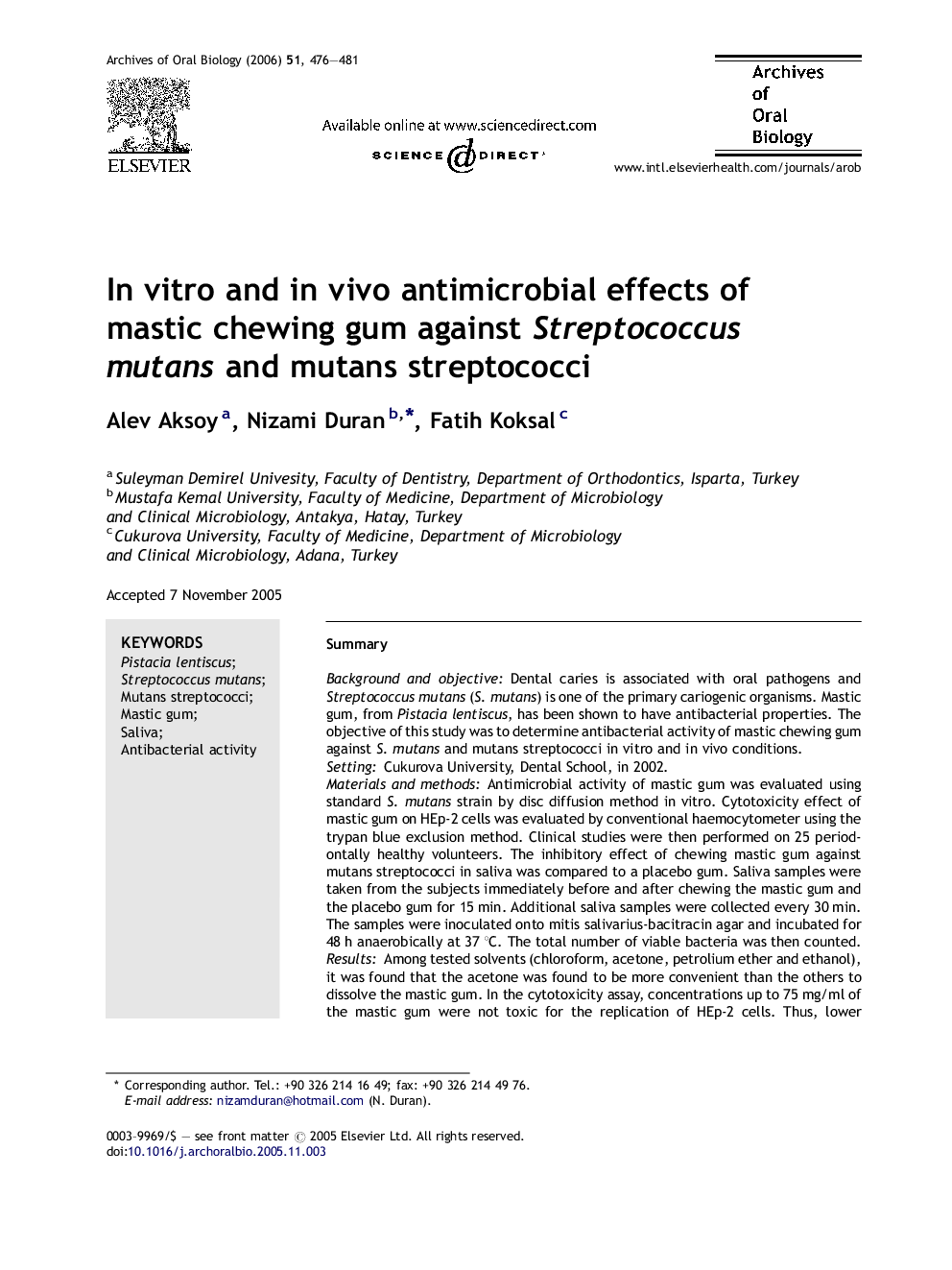| کد مقاله | کد نشریه | سال انتشار | مقاله انگلیسی | نسخه تمام متن |
|---|---|---|---|---|
| 3122014 | 1583409 | 2006 | 6 صفحه PDF | دانلود رایگان |

SummaryBackground and objectiveDental caries is associated with oral pathogens and Streptococcus mutans (S. mutans) is one of the primary cariogenic organisms. Mastic gum, from Pistacia lentiscus, has been shown to have antibacterial properties. The objective of this study was to determine antibacterial activity of mastic chewing gum against S. mutans and mutans streptococci in vitro and in vivo conditions.SettingCukurova University, Dental School, in 2002.Materials and methodsAntimicrobial activity of mastic gum was evaluated using standard S. mutans strain by disc diffusion method in vitro. Cytotoxicity effect of mastic gum on HEp-2 cells was evaluated by conventional haemocytometer using the trypan blue exclusion method. Clinical studies were then performed on 25 periodontally healthy volunteers. The inhibitory effect of chewing mastic gum against mutans streptococci in saliva was compared to a placebo gum. Saliva samples were taken from the subjects immediately before and after chewing the mastic gum and the placebo gum for 15 min. Additional saliva samples were collected every 30 min. The samples were inoculated onto mitis salivarius-bacitracin agar and incubated for 48 h anaerobically at 37 °C. The total number of viable bacteria was then counted.ResultsAmong tested solvents (chloroform, acetone, petrolium ether and ethanol), it was found that the acetone was found to be more convenient than the others to dissolve the mastic gum. In the cytotoxicity assay, concentrations up to 75 mg/ml of the mastic gum were not toxic for the replication of HEp-2 cells. Thus, lower concentrations of mastic gum (20 and 50 mg/ml) were used for the experiments. In vitro experiments, the diameters of growth inhibition zones of mastic gum were in the range 9.0–27.0 mm. In the clinical trials, the mean number of bacteria in samples taken after chewing the mastic gum and placebo gum were following; at minute 15 was 112 × 104 ± 268 × 103 and 175 × 104 ± 417 × 103 cfu/ml, for minute 45 was 85 × 104 ± 219 × 103 and 165 × 104 ± 329 × 103 cfu/ml, at minute 75 was 65 × 104 ± 100 × 103 and 160 × 104 ± 216 × 103 cfu/ml, at minute 105 was 60 × 104 ± 127 × 103 and 150 × 104 ± 138 × 103 cfu/ml, and at minute 135 was 55 × 104 ± 65 × 103 and 145 × 104 ± 354 × 103 cfu/ml, respectively. Significantly fewer bacteria was found in saliva samples collected after chewing mastic gum compared to those after chewing paraffin (p < 0.001).ConclusionsThis preliminary study showed that mastic gum had significant antibacterial activity against S. mutans and mutans streptococci and it may be a useful adjunct in the prevention of caries.
Journal: Archives of Oral Biology - Volume 51, Issue 6, June 2006, Pages 476–481